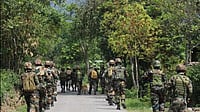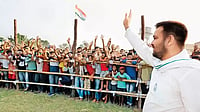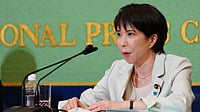No wonder The Guardian in its editorial, Still No Smoking Gun, thought the case against bin Laden as published by the British government "would be almost worthless from a legal point of view". Similarly, the foreign editor of The Times, London, Bronwen Maddox, described the document as a "puzzling and worrying piece of work" and proferred the opinion that "only if it is read as a political text does it seem shrewd".
Pointing out that the commentary extensively catalogues the involvement of Saudis in attacks on the US embassy in Nairobi and on the uss Cole, Maddox wondered why no link at all to Saudi Arabia has been drawn in the September 11 attacks, though "some of the hijackers were said to have been recruited in Saudi Arabia". More importantly, she wrote, "We should perhaps think of it (the document) as a paper shield for President Musharraf of Pakistan and the royalty of Saudi Arabia to hold between them and their angry people."
Indeed, the omissions from the document are probably more significant than the submissions. These omissions are palpably political in nature. Though the document points out that "Al Qaeda and the Taliban regime have a close and mutually dependent alliance", it fails to mention Pakistan's role in incubating, rearing, nurturing as well as providing tactical, strategic and other logistical support to the Taliban. In short, nothing the Taliban did could have been possible without Pakistan's active support.
There have been reports of Pakistani uniformed personnel in custody of the Northern Alliance. "What were Pakistani army officers doing in Afghanistan? Surely they didn't go there on picnic?" remarks a government official. Indian government sources say as many as 200 Pakistanis are in the custody of the Northern Alliance.
Besides providing the Taliban with logistical support, Pakistan also gave them money. Ahmed Rashid provides some figures in his authoritative book Taliban: Militant Islam, Oil and Fundamentalism in Central Asia: "In 1997/8, Pakistan provided Taliban with an estimated US $30 million in aid. This included 600,000 tonnes of wheat, diesel, petroleum and kerosene fuel, which were partly paid for by Saudi Arabia, arms and munitions, aerial bombs, maintenance and spare parts for its Soviet-era military equipment such as tanks and heavy artillery, repairs and maintenance of Taliban's air force and airport, road-building, electricity supply in Kandahar and salaries.Officially, Pakistan denied it was supporting the Taliban."
But if one were to go strictly by the document Blair made public before he went on to embrace Gen Pervez Musharraf in Islamabad last week, it would give rise to the misleading impression that bin Laden and the Taliban have no connections whatsoever. As a senior government official puts it, "What the US has done in Afghanistan is set a thief to catch a thief but without any mention of his thieving ways."
Officials also point out that specific evidence of bin Laden's guilt and that of Al Qaeda's "associates" has not been provided on the plea of protecting intelligence sources. In any case, the so-called evidence is of a very presumptive nature. Like Point 69 of the document, which says, "No other organisation has both the motivation and the capability to carry out attacks like those of September 11—only the Al Qaeda network and Osama bin Laden." Although Point 33 makes a less than fleeting mention of Al Qaeda operating "guest houses and training camps" in Pakistan, it fails to point out whether or not Islamabad knew of it.
No wonder Indian officials stress that their evidence of Pakistan's organic links with terrorism in Afghanistan and Jammu and Kashmir are far more compelling than what the British document has put out connecting bin Laden to the wtc.
Officials say the incidence of Pakistanis coming into j&k is extensively documented in hundreds of interrogation reports of those nabbed by the security forces. This is further testified by the 60 Pakistani prisoners languishing in jails in Jammu and Kashmir. It is well evidenced from intercepts in form of "voice logs" of Pakistani terrorists from across the border giving directions and receiving requests for arms and ammunition from their operatives.
Terrorist publications like Al Dawa of the Lashkar-e-Toiba (LeT) regularly provide details of those killed during skirmishes with security forces in j&k. The Al Dawa diary published last year listed 1,100 names of those who died the previous year, the names of their parents, the date and place they died and other such details, including code names. A senior official says that from published details, it is evident that 70 per cent of these come from Punjab in Pakistan, about 10 to 12 per cent from nwfp, three per cent each from tribal areas and Sindh. Those from PoK, ironically, are a mere three per cent.
So far as the Taliban is concerned, the Pakistani magazine The Herald in its January 2000 issue on the IC-814 hijack says that Taliban foreign minister Mullah Abdul Wakil Muttawakil revealed the identity of one of the hijackers when nothing was known about them. The writer, Zafar Abbas, said: "The day the Indian aircraft arrived in Kandahar, Muttawakil told the bbc's Pashto service that one of the hijackers was Maulana Masood Azhar's brother (Athar) Ibrahim. Understandably, Pakistan's initial response to the revelation was complete silence; given the situation, Pakistan would have found it highly problematic to challenge the Taliban foreign minister." The obvious question: how could the Taliban know about the identity of the hijackers before anyone had a clue about them?
Indian officials who flew to Kandahar to negotiate during the crisis remember the fond way Masood Azhar was greeted by the Taliban corps commander of Kandahar, Gen Usmani, as if "they were long-lost brothers".
In terms of Pakistan-sponsored activities in j&k, government sources cite the case of the January 26, 1995, blasts at Jammu's Maulana Azad Memorial Stadium, where Governor Krishna Rao was addressing a gathering.The interrogation of the culprit, Mohammed Irfan alias Anwar, son of Mohammed Ayub Khan, a resident of Tanda in Pakistan, revealed that the attack had been planned by the Sialkot unit of the isi and Hizbul Mujahideen leaders. In this terrorist operation, six people died and another 40 suffered splinter injuries.
In the Chitsinghpura massacre of March 20, 2000, in which 36 Sikhs were shot dead, the LeT's involvement was conclusively proved when Mohammed Suhail alias Aamir alias Abu Saharia, a resident of Sialkot, was arrested on August 16, 2000. The accused, who had been trained at the LeT's Umal Qura training camp in 1997-98, admitted to having participated in the massacre on the direction of the Lashkar's central leadership. He is now in the capital's Tihar jail.
Whenever such evidence was presented to western nations, they expressed reluctance to accept interrogation reports as proof. Now to put things in perspective: US deputy secretary of state Richard Armitage told cnn on October 3 that part of the evidence against bin Laden constitute evidence "gleaned from interrogations of people who have been picked up, as they say, busted".





















